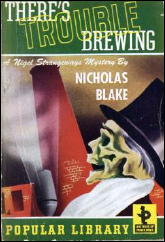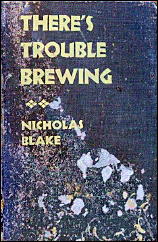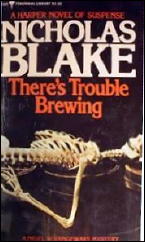Sun 13 Mar 2011
A Review by Tina Karelson: NICHOLAS BLAKE – There’s Trouble Brewing.
Posted by Steve under Reviews[5] Comments

NICHOLAS BLAKE – There’s Trouble Brewing. Collins Crime Club, UK, hardcover, 1937. Harper & Brothers, US, hc, 1937. Paperback reprints include: Popular Library #30, 1944; Perennial, 1982.
This is the third of the 16 Nigel Strangeways mysteries and earliest of the four that have lurked unread upon my shelves for the last 20 years or more.
Blake, of course, is a pseudonym for the poet Cecil Day Lewis. And the Strangeways novels are the product of a poet and scholar whose purpose in writing mysteries was to make some extra money to support his growing family. While he’s giving a bit of a tweak to the genre as it existed in Britain at the time, he stays within its boundaries.

In fact, the traditional elements are quite rigid. The story unfolds chronologically, each chapter designated with a number, date and time. For example, the eighth chapter is “VIII. July 19, 8.20–11.30 A.M.” Each chapter has an epigraph; these are drawn from a variety of sources, from Shakespeare to a 19th century temperance ballad.
The sleuth, Nigel Strangeways, is a classic upper-class amateur. In this case, he is summoned to the village of Maiden Astbury by an Oxford classmate’s wife, ostensibly to address the local literary society on the topic of his “delightful little book on the Caroline poets.” He ends up investigating a gruesome murder in a brewery, foreshadowed by the similar disposal of the brewery owner’s dog, subject of the book’s opening:

The educated, slightly tongue-in-cheek tone is maintained throughout. While gently amusing, it distances the reader from the story and characters.
Plot and structure are similarly flawed; more than one significant character is offstage for all or most of the book, existing only through other characters’ eyes and according to the physical traces left behind. The total effect is of a puzzle with missing pieces, viewed from afar.
Previously reviewed on this blog:
Murder with Malice [by Marv Lachman]
Thou Shell of Death [by Steve Lewis]
The Private Wound [by Steve Lewis]
March 13th, 2011 at 5:27 pm
I thought the portrayal of the British businessman in this one was pretty…corrosive!
March 13th, 2011 at 6:26 pm
All in all not one of the best Blake’s, though as Curt said the portrayal of the businessmen was savage — to be expected when your sleuth is modeled on Auden and T. S. Eliot.
Blake got much much better, and added considerable suspense to the mix as time went on.
Reading these I always had Herbert Marshall in mind as Nigel, though I can’t help but wonder how Daniel Day Lewis might fare in the role.
And Cecil Day Lewis wasn’t just a poet, he was the Poet Laureate of Great Britain, the wquivalent here would have been if Robert Frost had decided to pen a few hard boiled mysteries:
‘The woods were dark an deep.
Two roads diverged.
I took the one less traveled, a mean street in a dark wood.’
Or something like that.
March 14th, 2011 at 12:50 am
This is one of Blake’s more Rhodeian tales (by coincidence a John Rhode tale, Death in the Hop-fields, appeared the same year). So naturally I liked it! But it is more a puzzle for mental stimulation than an emotional entanglement. Still, I’m sure the good Lord loves puzzles too.
March 14th, 2011 at 12:53 am
Oh, David, I do think it’s a bloody shame that Daniel Day-Lewis never played Strangeways.
March 14th, 2011 at 3:49 am
Curt
He’s not exactly my idea of the character, but he would be great in the role. You would think once in a while someone would mention, ‘Oh, by the way, your father was Poet Laureate and a very popular mystery writer …” Just once.
I don’t mind pure puzzle stories, this one just didn’t read like the best of Blake. In a way there are almost two distinct Strangeways, the pre-war model married to Georgina and the post war version kicking around with the widow. A bit like the three or four distinct Ellery Queen’s.
Maybe we should take a cue from W. Vivian Butler, who in his DURABLE DESPERADOS identified the Mark I, II, III, IV, and V Simon Templar. Strangeways Mark I & II and Ellery Mark I-IV.